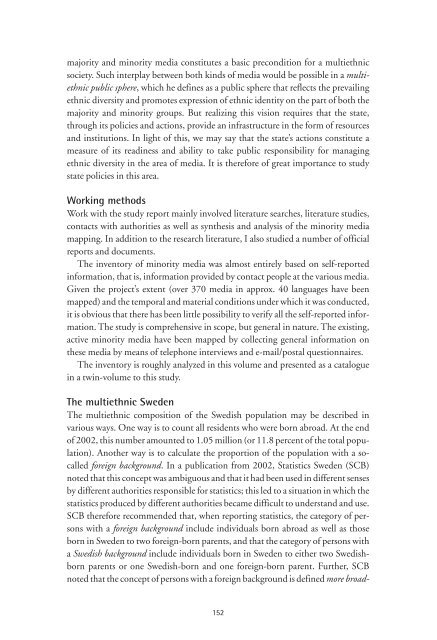Minoritetsmedier och minoritetsmediepolitik i Sverige - Myndigheten ...
Minoritetsmedier och minoritetsmediepolitik i Sverige - Myndigheten ...
Minoritetsmedier och minoritetsmediepolitik i Sverige - Myndigheten ...
You also want an ePaper? Increase the reach of your titles
YUMPU automatically turns print PDFs into web optimized ePapers that Google loves.
majority and minority media constitutes a basic precondition for a multiethnic<br />
society. Such interplay between both kinds of media would be possible in a multiethnic<br />
public sphere, which he defines as a public sphere that reflects the prevailing<br />
ethnic diversity and promotes expression of ethnic identity on the part of both the<br />
majority and minority groups. But realizing this vision requires that the state,<br />
through its policies and actions, provide an infrastructure in the form of resources<br />
and institutions. In light of this, we may say that the state’s actions constitute a<br />
measure of its readiness and ability to take public responsibility for managing<br />
ethnic diversity in the area of media. It is therefore of great importance to study<br />
state policies in this area.<br />
Working methods<br />
Work with the study report mainly involved literature searches, literature studies,<br />
contacts with authorities as well as synthesis and analysis of the minority media<br />
mapping. In addition to the research literature, I also studied a number of official<br />
reports and documents.<br />
The inventory of minority media was almost entirely based on self-reported<br />
information, that is, information provided by contact people at the various media.<br />
Given the project’s extent (over 370 media in approx. 40 languages have been<br />
mapped) and the temporal and material conditions under which it was conducted,<br />
it is obvious that there has been little possibility to verify all the self-reported information.<br />
The study is comprehensive in scope, but general in nature. The existing,<br />
active minority media have been mapped by collecting general information on<br />
these media by means of telephone interviews and e-mail/postal questionnaires.<br />
The inventory is roughly analyzed in this volume and presented as a catalogue<br />
in a twin-volume to this study.<br />
The multiethnic Sweden<br />
The multiethnic composition of the Swedish population may be described in<br />
various ways. One way is to count all residents who were born abroad. At the end<br />
of 2002, this number amounted to 1.05 million (or 11.8 percent of the total population).<br />
Another way is to calculate the proportion of the population with a socalled<br />
foreign background. In a publication from 2002, Statistics Sweden (SCB)<br />
noted that this concept was ambiguous and that it had been used in different senses<br />
by different authorities responsible for statistics; this led to a situation in which the<br />
statistics produced by different authorities became difficult to understand and use.<br />
SCB therefore recommended that, when reporting statistics, the category of persons<br />
with a foreign background include individuals born abroad as well as those<br />
born in Sweden to two foreign-born parents, and that the category of persons with<br />
a Swedish background include individuals born in Sweden to either two Swedishborn<br />
parents or one Swedish-born and one foreign-born parent. Further, SCB<br />
noted that the concept of persons with a foreign background is defined more broad-<br />
152

















